
Body whorl
Encyclopedia


Morphology (biology)
In biology, morphology is a branch of bioscience dealing with the study of the form and structure of organisms and their specific structural features....
of a coiled gastropod mollusk
Gastropod shell
The gastropod shell is a shell which is part of the body of a gastropod or snail, one kind of mollusc. The gastropod shell is an external skeleton or exoskeleton, which serves not only for muscle attachment, but also for protection from predators and from mechanical damage...
.
In gastropods
In gastropods, the body whorl, or last whorl, is the most recently-formed and largest whorlWhorl (mollusc)
A whorl is a single, complete 360° revolution or turn in the spiral growth of a mollusc shell. A spiral configuration of the shell is found in of numerous gastropods, but it is also found in shelled cephalopods including Nautilus, Spirula and the large extinct subclass of cephalopods known as the...
(or revolution) of a spiral
Spiral
In mathematics, a spiral is a curve which emanates from a central point, getting progressively farther away as it revolves around the point.-Spiral or helix:...
or helical shell
Gastropod shell
The gastropod shell is a shell which is part of the body of a gastropod or snail, one kind of mollusc. The gastropod shell is an external skeleton or exoskeleton, which serves not only for muscle attachment, but also for protection from predators and from mechanical damage...
, terminating in the aperture
Aperture (mollusc)
The aperture is an opening in certain kinds of mollusc shells: it is the main opening of the shell, where part of the body of the animal emerges for locomotion, feeding, etc....
. It is called the "body whorl" because most of the body of the soft parts of the animal fits into this whorl.
The proportional size of the body whorl in gastropod shells differs greatly according to the actual shell morphology. For shells in which the rate of whorl expansion of each revolution around the axis is very high, the aperture and the body whorl are large, and the shell tends to be low spired
Spire (mollusc)
A spire is a descriptive term for part of the coiled shell of mollusks. The word is a convenient aid in describing shells, but it does not refer to a very precise part of shell anatomy: the spire consists of all of the whorls except for the body whorl...
. The shell of the abalone
Abalone
Abalone , from aulón, are small to very large-sized edible sea snails, marine gastropod molluscs in the family Haliotidae and the genus Haliotis...
is a good example of this kind of shell.
The opposite tendency can sometimes create a high spire with very little whorl increase per revolution. In these instances, e.g. in the shell of Turritella
Turritella
Turritella is a genus of medium-sized sea snails with an operculum, marine gastropod mollusks in the family Turritellidae. They have tightly coiled shells, whose overall shape is basically that of an elongated cone....
species, both the body whorl and the aperture are relatively small.
In mollusc shells where there is no elevation at all to the spire, and only moderate whorl expansion, the body whorl can sometimes still represent a large part of the shell, e.g. in some species in the family Planorbidae
Planorbidae
Planorbidae, common name the ramshorn snails or ram's horn snails, is a family of air-breathing freshwater snails, aquatic pulmonate gastropod mollusks....
, such as the genus Segmentina
Segmentina
Segmentina is a genus of small, air-breathing, freshwater snails, aquatic gastropod mollusks or micromollusks in the family Planorbidae, the ramshorn snails....
.
See also
- body chamberBody chamberThe body chamber, also called the living chamber, is the outermost or last chamber in the shell of a nautiloid or ammonoid cephalopod. The body of the animal occupies the living chamber, apart from the siphuncle which extends through the rest of septa to provide buoyancy....
in shelled cephalopodCephalopodA cephalopod is any member of the molluscan class Cephalopoda . These exclusively marine animals are characterized by bilateral body symmetry, a prominent head, and a set of arms or tentacles modified from the primitive molluscan foot...
mollusks such as ammoniteAmmoniteAmmonite, as a zoological or paleontological term, refers to any member of the Ammonoidea an extinct subclass within the Molluscan class Cephalopoda which are more closely related to living coleoids Ammonite, as a zoological or paleontological term, refers to any member of the Ammonoidea an extinct...
s and nautilusNautilusNautilus is the common name of marine creatures of cephalopod family Nautilidae, the sole extant family of the superfamily Nautilaceae and of its smaller but near equal suborder, Nautilina. It comprises six living species in two genera, the type of which is the genus Nautilus...
, is an equivalent space and is also sometimes called the body whorl.

